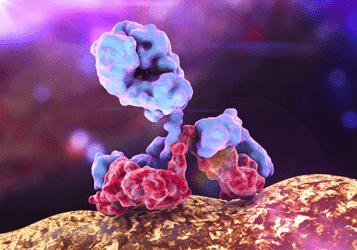- Home
- Products
- Customized ADCs
- PRLR
- Anti-PRLR-SMCC-DM1 ADC
Anti-PRLR-SMCC-DM1 ADC (CAT#: ADC-W-050)
This ADC product is comprised of an anti-PRLR monoclonal antibody conjugated via a SMCC linker to DM1. The DM1 is targeted to certain cancers by immunerecognition and delivered into cancer cells via receptor mediated endocytosis. Within the cell, DM1 binds to tubulins, interrupts microtubule dynamics, and subsequently, induces cell death.
- ADC Target
- ADC Antibody
- ADC Linker
- ADC payload drug
- Name
- PRLR
- Alternative Names
- PRLR; prolactin receptor; HPRL; MFAB; hPRLrI; hPRL receptor; secreted prolactin binding protein;
- Target Entrez Gene ID
- 5618
- Target UniProt ID
- P16471
- Overview
- This gene encodes a receptor for the anterior pituitary hormone, prolactin, and belongs to the type I cytokine receptor family. Prolactin-dependent signaling occurs as the result of ligand-induced dimerization of the prolactin receptor. Several alternatively spliced transcript variants encoding different membrane-bound and soluble isoforms have been described for this gene, which may function to modulate the endocrine and autocrine effects of prolactin in normal tissue and cancer.
- Overview
- Human Anti-PRLR antibody
- Host animal
- mouse
- Species Reactivity
- Human
- Name
- SMCC (N-succinimidyl 4-(Nmaleimidomethyl)cyclohexane-1-carboxylate)
- Description
- Noncleavable linkers, is considered noncleavable-meaning linker cleavage, and payload release does not depend on the differential properties between the plasma and some cytoplasmic compartments. Instead, the release of the cytotoxic drug is postulated to occur after internalization of the ADC via antigen-mediated endocytosis and delivery to lysosomal compartment, where the antibody is degraded to the level of amino acids through intracellular proteolytic degradation.
- Name
- DM1 (N2’-Deacetyl-N2’-(3-mercapto-1-oxopropyl)maytansine)
- Description
- Derived from Maytansinoid,a group of cytotoxins structurally similar to rifamycin, geldanamycin, and ansatrienin. The eponymous natural cytotoxic agent maytansine is a 19-member lactam (ansa
macrolide) structure originally isolated from the Ethiopian shrub Maytenus ovatus. Maytansinoids can bind to tubulin at or near the vinblastine-binding site, which interfere the formation of microtubules and depolymerize already formed microtubules, inducing mitotic arrest in the intoxicated cells.
For Research Use Only. NOT FOR CLINICAL USE.
Related Products
- Anti-IL4 (Pascolizumab)-MC-Vc-PAB-DMEA-(PEG2)-duocarmycin SA ADC (CAT#: ADC-W-1381)
- Anti-SLAMF7 (Elotuzumab)-MC-MMAF ADC (CAT#: ADC-W-1762)
- Anti-MS4A1 (Tositumomab)-SPDB-DM4 ADC (CAT#: ADC-W-1581)
- Anti-CDH1-PBD dimers ADC (CAT#: ADC-W-304)
- Anti-TPBG-Mc-MMAD ADC-3 (CAT#: ADC-W-159)
- Anti-CD79b-BMPEO-DM1 ADC-1 (CAT#: ADC-W-025)
- Anti-ITGAV (Abituzumab)-MC-MMAF ADC (CAT#: ADC-W-2440)
- Anti-MUC5A (Ensituximab)-MC-MMAF ADC (CAT#: ADC-W-1654)
- Anti-IFNAR (Anifrolumab)-SPDB-DM4 ADC (CAT#: ADC-W-2055)
- Anti-CR2-MCC-DM1 ADC (CAT#: ADC-W-330)
Published Data
+ Submit Publications

Scientific Resources
Customer Reviews and FAQs
There are currently no Customer reviews or questions for ADC-W-050. Click the button above to contact us or submit your feedback about this product.
Quick Links
Other Products
Same Linker
Same Payload
| CAT# | Product Name | Linker | Payload |
| ADC-W-2589 | Anti-EGFR (Cetuximab)-SMCC-DM1 ADC | SMCC (N-succinimidyl 4-(Nmaleimidomethyl)cyclohexane-1-carboxylate) | DM1 (N2'-Deacetyl-N2'-(3-mercapto-1-oxopropyl)maytansine) |
| ADC-W-457 | Anti-MST1R-SMCC-DM1 ADC-1 | SMCC (N-succinimidyl 4-(Nmaleimidomethyl)cyclohexane-1-carboxylate) | DM1 (N2’-Deacetyl-N2’-(3-mercapto-1-oxopropyl)maytansine) |
| ADC-W-473 | Anti-CD37-SMCC-DM1 ADC | SMCC (N-succinimidyl 4-(Nmaleimidomethyl)cyclohexane-1-carboxylate) | DM1 (N2’-Deacetyl-N2’-(3-mercapto-1-oxopropyl)maytansine) |
| ADC-W-495 | Anti-EGFR-SMCC-DM1 ADC-4 | SMCC (N-succinimidyl 4-(Nmaleimidomethyl)cyclohexane-1-carboxylate) | DM1 (N2’-Deacetyl-N2’-(3-mercapto-1-oxopropyl)maytansine) |
| ADC-W-2604 | Anti-ITGB3 (Tadocizumab)-SMCC-DM1 ADC | SMCC (N-succinimidyl 4-(Nmaleimidomethyl)cyclohexane-1-carboxylate) | DM1 (N2'-Deacetyl-N2'-(3-mercapto-1-oxopropyl)maytansine) |
| CAT# | Product Name | Linker | Payload |
| ADC-AA-026 | anti-MIgG(Fc)-N-DM1 ADC | Noncleavable linkers | DM1 (N2’-Deacetyl-N2’-(3-mercapto-1-oxopropyl)maytansine) |
| ADC-AA-008 | anti-HIgG(Fc)-N-DM1 ADC | Noncleavable linkers | DM1 (N2’-Deacetyl-N2’-(3-mercapto-1-oxopropyl)maytansine) |
| ADC-W-603 | Anti-FOLH1-SMCC-DM1 ADC-3 | SMCC (N-succinimidyl 4-(Nmaleimidomethyl)cyclohexane-1-carboxylate) | DM1 (N2’-Deacetyl-N2’-(3-mercapto-1-oxopropyl)maytansine) |
| ADC-AA-018 | anti-HIgG(Fab)-N-DM1 ADC | Noncleavable linkers | DM1 (N2’-Deacetyl-N2’-(3-mercapto-1-oxopropyl)maytansine) |
| ADC-AA-015 | anti-HIgG(Fc)Fab-N-DM1 ADC | Noncleavable linkers | DM1 (N2’-Deacetyl-N2’-(3-mercapto-1-oxopropyl)maytansine) |
Online Inquiry
Welcome! For price inquiries, please feel free to contact us through the form on the left side. We will get back to you as soon as possible.



